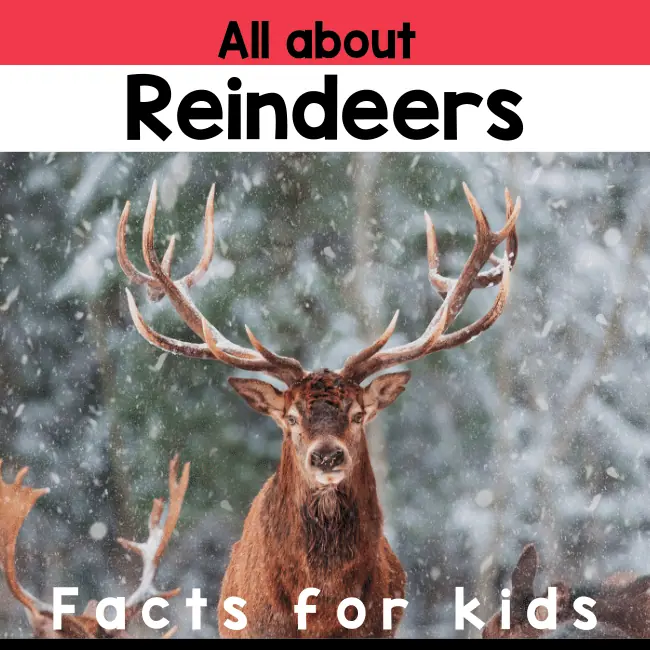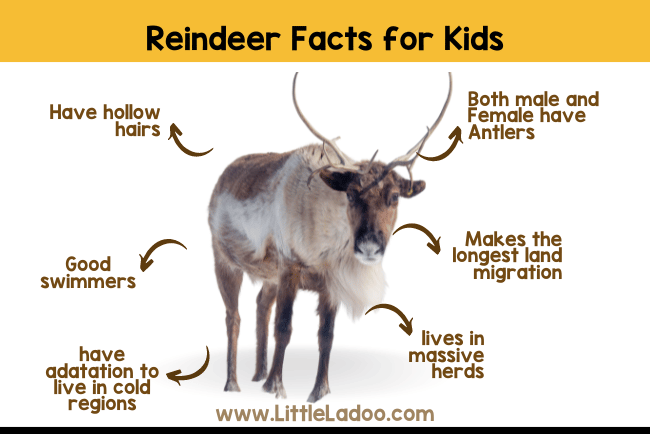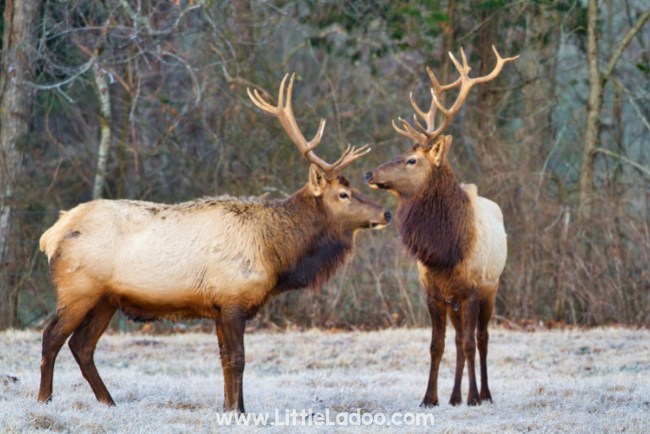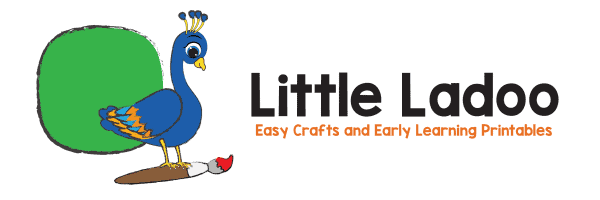All activities should be supervised by an adult. As an Amazon Associate, I earn from qualifying purchases. This post may contain affiliate links.
Reindeer are incredibly unique animals with many special adaptations that make them perfectly suited for wintertime study.
This blog post will share some fun and interesting Reindeer facts for kids to learn during the holiday season. So grab a mug of cocoa and cosy up to explore the world of enchanting reindeer!

Reindeer in Simple words
Reindeer is a Type of deer that has large horns called antlers. It lives in Northern Europe, Asia, and America. Reindeers are also known as caribou.
Important Reindeer facts
- Scientific Name :Rangifer tarandus
- Type: Mammal
- Life Span: 12-14 Years
- Diet: Herbivores
- Habitat: Tundra, Arctic, Subarctic and Mountainous regions
- Found in: Northern Europe, Siberia, and North America
Interesting Reindeer Facts for kids
- Reindeer are also known as caribou, especially in North America.
- Reindeer do not stay in the same place all year round.
- Reindeer migrate up to 3000 miles each year in search of food and shelter!
- Unlike other members of the deer family, Both male and female reindeer grow antlers.
- Their antlers are unique like our fingerprints – no two are alike!
- Reindeer can swim and they are good at it!
- A male is called a bull or Stag.
- A Female Reindeer is called a cow.
- The baby is called a Calf.
- Reindeers eat only Plants.
- Humans have hunted reindeer for thousands of years for their meat, fur and antlers.
- They can run very fast! Up to 50 miles per hour.
- Reindeers live in massive herds.
- Reindeer have the ability to make clicking noises as they walk.
- Reindeers are the most vocal species in the deer family. They communicate with Grunt and snorts.
- Reindeers are often associated with Christmas and Santa.
- Rudolph the red-nosed Reindeer is a hugely well-known myth that every child is aware of.
- Reindeer have excellent eyesight and can see ultraviolet light which helps them spot predators from far away.
- They can also hear extremely low frequencies which allow them to detect hiding predators in darkness.
- A reindeer’s milk has more fat than a cow’s milk.

Are reindeer and Caribou the same?
Yes, Reindeer and caribou are actually the same – Rangifer tarandus. In Northern Europe and Asia, they are called Reindeer, while they are called caribou in North America and Greenland.
Where do reindeer live?
Reindeer live in some of the coldest regions on earth; the Northern parts of North America in Canada and Alaska. They also live in Northern Europe, Russia, and Greenland.
What do Reindeer eat?
Reindeer are herbivores that eat a variety of grasses, leaves, twigs, bark and mushrooms. In winter, they graze on lichens or mosses.
Who are the predators of reindeer?
Grey wolves, grizzly bears, brown bears, and wolverines are Reindeer predators. Native people have also hunted reindeer for food and clothing.
The Antlers of Reindeer
- Both male and female reindeer grow antlers.
- The Antlers of females are smaller than Males.
- Males typically shed their antlers around December while females keep theirs until they give birth in springtime.
- Antlers are used primarily during mating season as a status symbol – the bigger the antlers, the more attractive the mate!

What adaptions do the reindeer have to live in Cold regions?
- They have a thick, warm fur coat that helps them survive in temperatures as low as -50 degrees Fahrenheit!
- They use their large antlers to dig through snow and uncover food beneath the surface.
- In addition, their hooves are specially adapted for walking over icy terrain.
- Their fur is also waterproof to keep them from getting wet in snowy weather.
- Their noses are full of blood vessels that warm cold air up as it breathes in.
Does Reindeers Migrate?
Reindeers one of the longest-migrating (Land) mammals on the planet. They usually travel in large herds ranging from tens to thousands of animals and will migrate in response to changes in food supply or weather patterns.
How long does the Reindeer live?
The lifespan of reindeer typically ranges from 12-14 years if living wild. However, domesticated reindeer can live up to 20 years if properly taken care of by humans.
Do Reindeer have a red noses?
Yes, Actually, some reindeer have Red noses as a result of densely packed blood vessels near the skin’s surface.
How did Reindeer got associated with Santa?
Do you ever wonder why Santa’s sleigh is shown as pulled by reindeer?
Historically, reindeer have been a source of transportation for Arctic Indigenous communities including the Sami people of Lapland. It’s no surprise then that, eventually, these magical creatures became associated with Santa Claus in the popular imagination.
Depictions of Santa sleighing across the skies on a team of reindeer cropped up in literature and public consciousness as early as 1823 and have continued to be elaborated upon since then.
Today, the idea that Santa is the reindeer master has become so ingrained in popular culture that it’s almost impossible to think of one without the other!
What are the Names of Santa’s 9 reindeer?
Dasher, Dancer, Prancer, Vixen, Comet, Cupid, Donner, and Blitzen and the most famous reindeer of all – Rudolph the red-nosed reindeer.
Did you enjoy learning these Reindeer facts for kids? From their adaptable lifestyle and incredible abilities, these animals have some pretty fascinating qualities.
Reindeer Themed-Activities for kids:
Here are some fun Activities that you can do to make a comprehensive Reindeer unit for kids.
Reindeer Crafts
- Paper Plate Reindeer Craft
- Handprint reindeer Craft
- Popsicle stick Reindeer Craft
- Handprint Reindeer Craft

Learn to draw a Reindeer
Learning about Reindeer
Reindeer Activities for kids
I hope you found Reindeer facts for kids and the list of activities Helpful! Pin this blog for later!
You might also like Hedgehog Facts for kids
